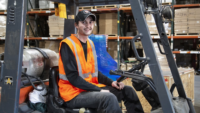That’s Peter Bamford speaking. Bamford was director of corporate safety for Canadian National (CN) Rail in March 1999, when a double fatality at one of the company’s subsidiaries led to an extensive program aimed at the human side of safety.
CN Rail, which operates almost 18,000 route miles in Canada and the U.S., and has 21,600 employees, is committed to maintaining its physical plant and facilities. It has installed 350 wayside inspection systems, for instance. CN Rail also spends upwards of $50 million each year on employee training, much of it safety-related. Each shift is required to begin with a job briefing, for example. These kinds of safety investments contributed to CN Rail’s ranking as the safest Class 1 railroad.
But the fatalities (and a high injury frequency rate) at the mechanical department of the former Grand Trunk Western Railroad, a U.S. subsidiary of Canadian National, showed that the commitment to safety was not having the desired effect in all corners of the organization.
A new focus
A human factors development program for the mechanical department’s 300 employees was launched after an investigation of the fatalities considered possible faulty procedures, job factors, and human factors. Employees in the department’s five shops inspect and repair railcars and locomotives while in the yard. Bamford steered clear of calling this new initiative a “behavior-based” program due to negative connotations, he says. Implementing the program took a lot of work and a lot of talking, he recalls. “Communication is the starting point,” he says. “People have to know what goes into the human side of safety (see sidebar) before they can understand it.”Removing safety from labor relations was another key prerequisite. “Safety is not negotiable. It’s not a bargaining chip in the process of labor relations. It’s everybody’s responsibility, and everybody has different responsibilities within it,” says Bamford.
With these ground rules set, a two-day train-the-trainer session for union and safety reps followed. Training was then extended to about 180 of the employees in the mechanical department (the remainder were either on vacation, extended medical leave, or off shift). Five units of training were spread over a period of ten weeks.
First impressions
To understand how workers reacted, you need to appreciate their culture. “It hasn’t changed much since the first round wheel met the flat rail 165 years ago,” remarks Bamford. “You can’t tell them which way’s up or down because they know it all.”At first, these rugged individualists were unimpressed. “They thought it was kind of basic,” says John Geary, a district safety coordinator. But disdain soon turned to approval. “Once they got into it, they ranted and raved, ‘This makes sense. It’s so simple and easy to understand, but it makes sense’,” recalls Geary.
Results came quickly. Ten minutes after completing the first unit of training, an employee was driving on an interstate when his cell phone rang. He started to answer it, hesitated, then decided not to. He later told Bamford that he knew if he answered the call, he wouldn’t be able to keep his mind and eyes on his driving.
Employees throughout the department began talking about safety during job briefings and while working underneath railcars: “Are you in the line of fire?” “Watch yourself now, you’re rushing.” “Let’s not get complacent. Think about what you’re doing.”
“If people are talking about safety — good or bad — you’ve won,” says Bamford. If people are talking about safety in a good way, you’ve really won.”
The payoff
Looks like CN Rail and its employees are winners. During the first six months after the initial training (the last two quarters of 1999), not one person who had been trained was involved in any reportable incident, minor injury, or first aid. Injuries were confined to employees who had not received the training. In the first quarter of 2000, only two of the 180 employees trained had been injured, in both cases minor, non-reportable injuries.“Working on human factors does work,” says Bamford. Working on both job factors (the physical plant and safe procedures) and human factors together delivers immediate returns.
The human factors development program “isn’t meant to replace anything we’re already doing, like correcting safety concerns, or replacing procedures or training,” says Geary. “This is an extra tool that employees can use for their own safety awareness. It makes employees more aware of what they’re doing, and more conscientious about getting out there and understanding what they need to do to protect themselves.”
